
Need for circuit protection.
Circuit protection is employed to protect wires and electrical equipment from damage in the event of an electrical overload, short circuit, or ground fault. Lightning storms, overloaded power outlets, or a sudden electrical surge may result in a dangerous situation with the potential to cause fire, equipment damage, or personal injury. Circuit protection is designed to eliminate this risk before it occurs by cutting off the power to the circuit. All set to gamble together with jugar tragamonedas gratis cleopatra.
Trip Curves is also commonly known as Time Current Curves

Simply put, a trip curve is a graphical representation of the expected behavior of a circuit protection device. Circuit protection devices come in many forms, including fuses, miniature circuit breakers, molded case circuit breakers, supplementary protectors, motor protection circuit breakers, overload relays, electronic fuses, and air circuit breakers.
We need different trip curves in order to balance the right amount of overcurrent protection against optimal machine operation. Choosing a circuit breaker with a trip curve that trips too soon can result in nuisance tripping. Choosing a circuit breaker that trips too late can result in catastrophic damage to the machine and cables.
Circuit breakers must trip quick enough to avoid equipment or wiring failure, but not so fast as to give false, or nuisance trips.
To avoid nuisance trips, circuit breakers need to be sized appropriately to compensate for inrush current.
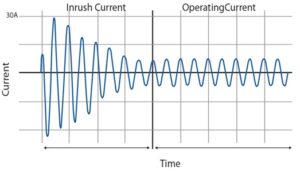
To understand a trip curve, it is helpful to understand how a miniature circuit breaker, or overcurrent protection device, functions. The figure below is a look at the inside of a Miniature Circuit Breaker (MCB).

1. Terminal for line/load power.
2. Bi-metallic strip. Bends with heat (current), separates contacts in response to smaller, longer-term over-currents, tripping the breaker.
3. Contacts. Current flows through when closed. Breaks current when separated.
4. Arc Chamber. Channels plasma arcing to arc divider.
5. Arc divider/extinguisher. Breaks the main arc into smaller arcs and extinguishes them.
6. Coil/Solenoid. Separates contacts in response to high overcurrents, such as a short circuit.
7. Actuator lever. Manually trips or resets breaker.
8. Actuator mechanism. Forces contacts together or apart.
With both a bi-metallic strip (2) and a magnetic coil/solenoid (6), a miniature circuit breaker can be two separate types of circuit protection device in one. The bi-metallic strip provides overload protection in response to smaller overcurrents, typically 10X the operating current. The metallic strip consists of two strips of different metals, formed together, which expand at different rates as they are heated. In an overload situation, the bimetallic strip bends and this movement actuates a trip mechanism and breaks (opens) the circuit. The strip converts a temperature change into mechanical displacement.
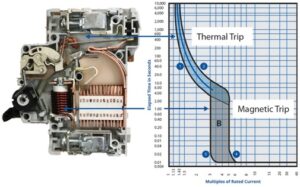
The magnetic coil or solenoid (6) reacts to fast, higher overcurrents caused by short circuits, typically greater than 10X the operating current – up to tens or hundreds of thousands of amperes. The high current causes a magnetic field to be generated by the coil, moving the internal piston quickly (within microseconds) to trip the actuator mechanism and break the circuit.
The Trip Curve
The figure is a Trip Curve chart.
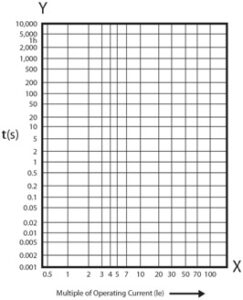
• The X-axis represents a multiple of the operating current of the circuit breaker.
• The Y-axis represents the tripping time. A logarithmic scale is used in order to showtimes from .001 seconds up to 10,000 seconds (2.77 hours) at multiples of the operating current.
The three major components of the Trip Curve are:
1. Thermal Trip Curve. This is the trip curve for the bi-metallic strip, which is designed for slower overcurrents to allow for in rush/startup, as described above.
2. Magnetic Trip Curve. This is the trip curve for the coil or solenoid. It is designed to react quickly to large overcurrents, such as a short circuit condition.
3. The Ideal Trip Curve. This curve shows what the desired trip curve for the bi-metallic strip is. Because of the organic nature of the bi-metallic strip, and changing ambient conditions, it is difficult to precisely predict the exact tripping point.
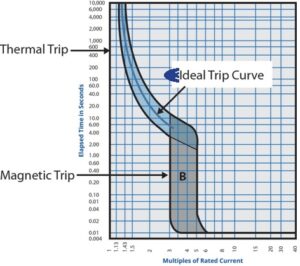
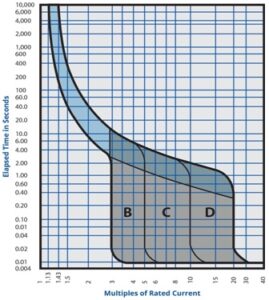
Class B trip curve
The MCB with class B trip characteristics trips instantaneously when the current flowing through it reaches between 3 to 5 times rated current. These MCBs are suitable for cable protection.
Class C trip curve
MCB with class C trip characteristics trips instantaneously when the current flowing through it reaches between 5 to 10 times the rated current. Suitable Domestic and residential applications and electromagnetic starting loads with medium starting currents.
Class D trip curve
MCB with class D trip characteristics trips instantaneously when the current flowing through it reaches between Above 10(excluding 10) to 20 times the rated current. Suitable for inductive and motor loads with high starting currents.
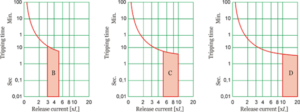
Class K trip curve
MCB with class K trip characteristics trips instantaneously when the current flowing through it reaches between 8 to 12 times the rated current. Suitable for inductive and motor loads with high inrush currents.
Class Z trip curve
MCB with class Z trip characteristics trips instantaneously when the current flowing through it reaches between 2 to 3 times the rated current. These type of MCBs are highly sensitive to short circuit and are used for the protection of highly sensitive devices such as semiconductor devices.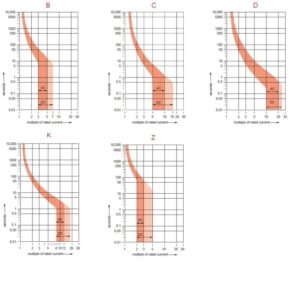
Trip curves for other circuit breakers
All circuit breakers, such as MCCB, ACB, VCB, etc have their own trip characteristics. The only thing is that may not follow the categorization as that of MCB. Also, the trip characteristics of every circuit breaker differ from that of the other.
